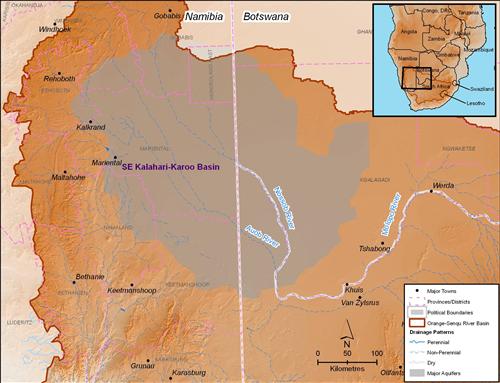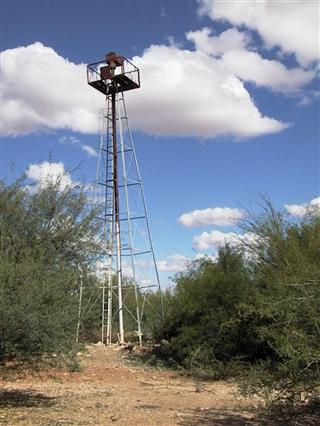Although 23% of the water used in the country is taken from surface-rivers, the majority of the population does not have access to these sources because of distances involved and the ephemeral nature of rivers in the east, west and central parts of Namibia (Christelis and Struckmeier 2001). Therefore, groundwater is an important source for urban water users in Namibia, and the primary source for rural and stock watering requirements. The Stampriet Artesian Basin is the largest source of groundwater in Namibia and is located to south-east of the country.
Groundwater also supports Namibia’s environmental water requirements, including those of many wetlands. In Namibia arid conditions can cause high rates of evaporation (up to 70% from open sources). One way of conserving water is to convert surface water into groundwater, by pumping water underground in times of surplus, artificially recharging the aquifer (Murray 2004). This approach to water conservation is known as Artificial Recharge. Examples can be seen throughout southern Africa, including Windhoek (Namibia), Polokwane (Limpopo Province, South Africa), and Calvinia (Northern Cape Province, South Africa). An alternative approach to artificial recharge is the practice of constructing sand storage dams and ground weirs in river beds, allowing water to seep back underground. This technique has been used in southern Africa since the beginning of the 20th century.

The Stampriet Artesian Basin.
Source:Hatfield 2009, adapted from UNDP 2009
( click to enlarge )
The groundwater and small-scale water supply schemes of the Orange-Senqu River basin in Namibia are important within the Fish-Aroab basin, southern Namib, the Karas Region, and the mouth of the Orange River. Within the Fish-Aroab Basin the largest town, Keetmanshoop, is fed by waters from the Naute Dam on the Lowen River, a small tributary of the Fish River. Smaller towns in the region rely on groundwater extracted from aquifers in the Nama Group.
In the southern Namib and Naukluft regions, the alluvial aquifer along the Orange River is the only reliable aquifer in this part of the country and is a source of domestic water for the Oranjemund area. The diamond mining processes at Oranjemund uses only seawater, which has no impact on the Orange River. The water supplied to Rosh Pinah and Skorpion Mines is abstracted with pump sets in a vertical water tower. The water abstracted at Noordoewer and Rosh Pinah is purified before distribution for domestic use. There is also a raw water pipeline from an abstraction tower to the Skorpion Mine (ORASECOM 2007a).
Very little water is available from groundwater in the Karas Region along the Orange River. An abundance of hand-dug wells along the rivercourses in the alluvium and river beds indicating that the area has been inhabited. A popular tourist attraction is the hot spring that reaches temperatures of 66° C in Ai-Ais along the Fish River.
Well-points are used to supply the domestic and mining water requirements of Alexander Bay at the mouth of the Orange River, as well as Port Nolloth to the south. There is also 761 ha of irrigated land on the left bank upstream of Oppenheimer Bridge, supplied with water from the Orange River by direct abstraction.
 An artesian borehole located on the Stampriet Artesian Aquifer, one of the largest sources of groundwater in southern Namibia. Source:Kirchner 2008 ( click to enlarge ) |
